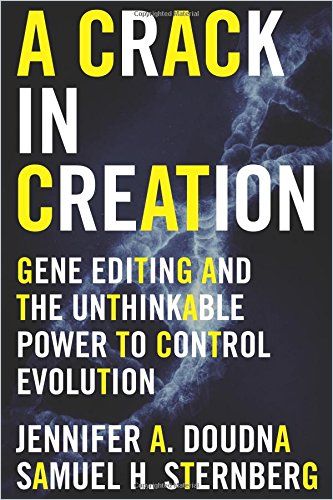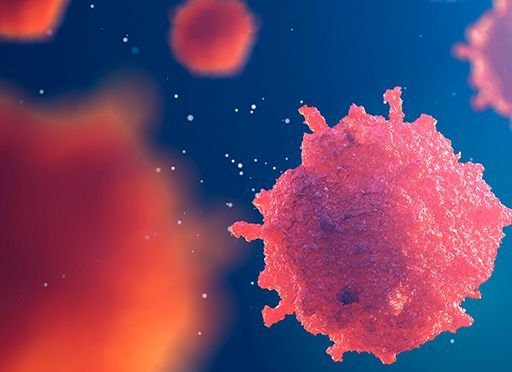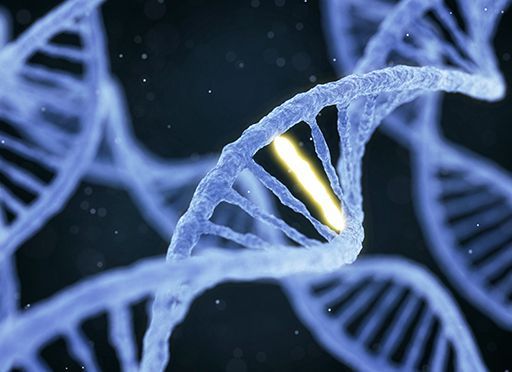Biochemists and genetic researchers Jennifer A. Doudna, PhD, and Samuel H. Sternberg, PhD, offer a deep dive into CRISPR gene editing, its potential and its possible ethical issues.

Gene Editing
Jennifer A. Doudna, PhD, and Samuel H. Sternberg, PhD, detail the history, ethical and safety issues, and likely applications of the gene-editing tool CRISPR, which enables scientists potentially to eliminate genes that cause cancer and other diseases, make food healthier, and even bring back extinct creatures like the woolly mammoth.
CRISPR
The CRISPR process, the authors explain, developed from research into an unusual DNA array found in bacterial cells. The array consisted of two types of alternating DNA sequences. One type, termed “repeats,” always contained an identical set of about 30 letters of DNA. These repeats were palindromic; their letters read the same forward and backward. Between each repeat was another DNA set, the interspace.
These “spacers” each contained a unique sequence of DNA letters. Scientists called the array CRISPR for “clustered regularly interspaced short palindromic repeats.”
CRISPR functions as an immune defense against bacteria’s natural enemy, the bacteriophages, viruses that infect bacteria by forcibly inserting their genetic information into bacterial cells.
The bacterial CRISPR system fights viruses by mobilizing so-called “CRISPR-associated genes” (cas genes), which code for enzymes that cut up the invading DNA. The bacteria copy the invading virus’s DNA and store it in the spacer regions of CRISPR. Then CRISPR constructs an archive of phage DNA, with which it recognizes and fights a repeat attack from the same type of virus.
This was…one of CRISPR’s greatest attributes – that it was fantastically easy to target specific genes.Doudna and Sternberg
Scientists use CRISPR to control genes remotely. They deactivate CRISPR’s cutting function and use the system to deliver “protein payloads” to specific genes. A payload includes molecules that influence how the gene gets expressed.
Disease Research and Treatment
Doudna and Sternberg detail how scientists could use the CRISPR technique to create more effective “animal models” – the organisms in which researchers replicate human diseases.
“Therapeutic gene editing” is on the horizon. Scientists already used CRISPR to cure genetic diseases and stop viral infections in cultured human cells. In 2013, researchers in China fixed a genetic mutation in a live mouse and subsequently cured mice of congenital cataracts, muscular dystrophy and metabolic disorders.
Researchers have been dreaming of DNA-based disease cures for as long as they’ve known about genetic disease.Doudna and Sternberg
To deliver CRISPR to the location of a DNA mutation, scientists remove cells from the body, edit them and put them back. The approach has promise for blood diseases such as sickle cell disease and beta thalassemia. Or, scientists send CRISPR straight into the patient’s body to treat diseases of the tissues, such as Duchenne muscular dystrophy.
CRISPR promises significant advances in the study and treatment of cancer. At present, CRISPR’s primary therapeutic contribution lies in providing support for established therapies such as immunotherapy, which enlists the body’s immune system.
Improved Food Production
CRISPR, the authors report, can help boost food crops’ natural immunity to disease and pests. Researchers hope to make foods healthier, by, for example, lowering the trans-fatty content of soybean oil. Scientists may apply gene-editing techniques to increase the volume and quality of an animal’s meat while reducing the fat.
Weighing the dangers inherent in a technology like CRISPR against the responsibility to use its power for the benefit of humanity and our planet will be a test like no other.Doudna and Sternberg
GMO foodstuffs are the result of recombinant DNA technology and gene splicing. Such crops produce increased yields with a reduced need for chemical pesticides and herbicides. However, GMO foods spark criticism and protest. Gene-edited foods may evoke similar controversy even though they result from a different technology. Yet, the authors point out, changing foods through gene editing is a faster and more controllable version of methods farmers have traditionally utilized for centuries to boost plants’ health and other desirable traits.
Unethical or Dangerous Practices
Some potential CRISPR uses seem like science fiction; labs could produce unicorns or dragons. Consumers might order customized pets; one Chinese institute, for example, currently offers 30-pound micro pigs as pets.
Some Harvard scientists want to apply CRISPR to resurrect the extinct woolly mammoth. Using a “fully sequenced” genome from mammoths that lived tens of thousands of years ago, researchers hope to convert, little by little, the genes in modern elephant cells to the mammoth “variant.” If the scientists can produce an elephant pregnancy utilizing those cells, the offspring would carry the mammoth genome and develop in accordance with its instructions.
If editing germ cells becomes socially acceptable, Doudna and Sternberg warn, people could enhance certain traits in their offspring, such as intelligence, appearance, and artistic or athletic abilities.
We have to acknowledge that [CRISPR] might also be used to create genetic enhancements – changes in which DNA is altered not to correct a harmful gene variant but to provide some type of genetic advantage.Doudna and Sternberg
The “gene drive” allows bioengineers to release new genes into “wild populations.” The technique increases the frequency of a trait in each succeeding generation. For example, if scientists introduced a gene for female sterility into a mosquito population, the gene would become increasingly more prevalent until it wiped out an entire mosquito species. But if scientists set this technique into motion, they couldn’t stop it – a terrifying thought, given that no one can foresee the potential consequences.
Responsible Decisions
Scientists and concerned members of the public must debate whether society should allow the manipulation of genes in germ cells, thereby creating heritable traits.
Nations need to maintain regulatory environments that are hospitable enough to permit research and clinical applications but strict enough to prevent the worst excesses.Doudna and Sternberg
To enable the public to make responsible decisions, the authors counsel, scientists must educate society. If scientific advances outstrip public understanding, a backlash could halt progress.
Complexity for Laypeople
Doudna and Sternberg present an almost unimaginably complex subject in terms directed to laypeople. Their in-depth knowledge enables, rather than impedes, their ability to explain CRISPR and related technologies, so nonscientists can grasp its underlying concepts and likely applications. While their overview is not light reading, it isn’t daunting either, if you’re willing to read a few pages more than once. Doudna and Sternberg don’t mind admitting the awe this technology evokes. Their mission is to share that awe and educate the public. They succeed.
Other books on gene editing include The $1,000 Genome by Kevin Davies; The Gene by Siddhartha Mukherjee; and Hacking Darwin by Jamie Metzl.











